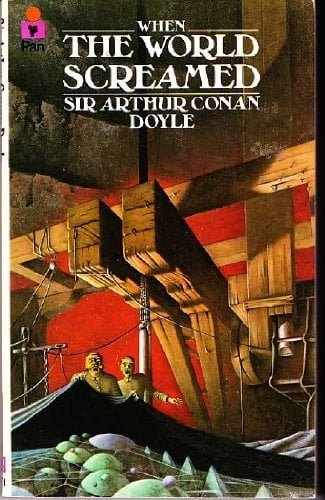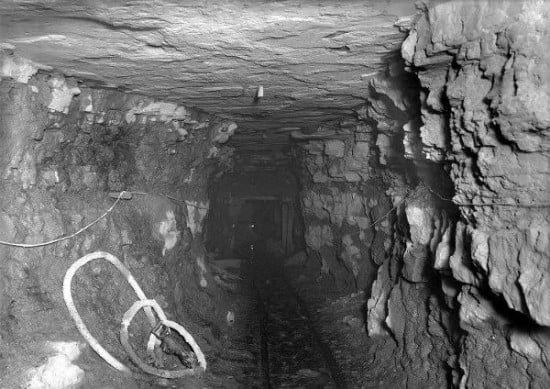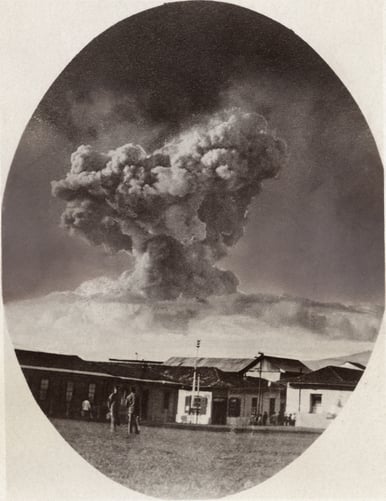When the World Screamed (10)
By:
November 17, 2015

Arthur Conan Doyle’s novella When the World Screamed was first published in 1928. The fifth and final Professor Challenger adventure, it takes us not outward (e.g., to a South American plateau crawling with dinosaurs), nor inward (e.g., to an airtight chamber, while the Earth passes through a poison belt), but instead downward. Challenger, here described as “a primitive cave-man in a lounge suit,” while also “the greatest brain in Europe,” proposes to drill his way from a tract of land in Sussex (England) eight miles beneath the planet’s epidermis. Why? In order to prove his hypothesis that the world is itself a living organism! Enjoy.
An audience after one of Challenger’s harangues usually felt as if, like the earth, its protective epidermis had been pierced and its nerves laid bare. This assembly was no exception, and there was a dull murmur of criticism and resentment as they returned to their places.
Challenger sat alone on the top of the mound, a small table beside him, his black mane and beard vibrating with excitement, a most portentous figure. Neither Malone nor I could admire the scene, however, for we hurried off upon our extraordinary errand. Twenty minutes later we were at the bottom of the shaft, and had pulled the tarpaulin from the exposed surface.

It was an amazing sight which lay before us. By some strange cosmic telepathy the old planet seemed to know that an unheard-of liberty was about to be attempted. The exposed surface was like a boiling pot. Great grey bubbles rose and burst with a crackling report. The air-spaces and vacuoles below the skin separated and coalesced in an agitated activity. The transverse ripples were stronger and faster in their rhythm than before. A dark purple fluid appeared to pulse in the tortuous anastomoses of channels which lay under the surface. The throb of life was in it all. A heavy smell made the air hardly fit for human lungs.
My gaze was fixed upon this strange spectacle when Malone at my elbow gave a sudden gasp of alarm. ‘My God, Jones!’ he cried. ‘Look there!’
I gave one glance, and the next instant I released the electric connection and I sprang into the lift. ‘Come on!’ I cried. ‘It may be a race for life!’
What we had seen was indeed alarming. The whole lower shaft, it would seem, had shared in the increased activity which we had observed below, and the walls were throbbing and pulsing in sympathy. This movement had reacted upon the holes in which the beams rested, and it was clear that a very little further retraction — a matter of inches — the beams would fall. If they did so then the sharp end of my rod would, of course, penetrate the earth quite independently of the electric release. Before that happened it was vital that Malone and I should be out of the shaft. To be eight miles down in the earth with the chance any instant of some extraordinary convulsion taking place was a terrible prospect. We fled wildly for the surface.
Shall either of us ever forget that nightmare journey? The lifts whizzed and buzzed and yet the minutes seemed to be hours. As we reached each stage we sprang out, jumped into the next lift, touched the release and flew onwards. Through the steel latticed roof we could see far away the little circle of light which marked the mouth of the shaft. Now it grew wider and wider, until it came full circle and our glad eyes rested upon the brickwork of the opening. Up we shot, and up — and then at last in a glad moment of joy and thankfulness we sprang out of our prison and had our feet upon the green sward once more. But it was touch and go. We had not gone thirty paces from the shaft when far down in the depths my iron dart shot into the nerve ganglion of old Mother Earth and the great moment had arrived.

What was it happened? Neither Malone nor I was in a position to say, for both of us were swept off our feet as by a cyclone and swirled along the grass, revolving round and round like two curling stones upon an ice rink. At the same time our ears were assailed by the most horrible yell that ever yet was heard. Who is there of all the hundreds who have attempted it who has ever yet described adequately that terrible cry? It was a howl in which pain, anger, menace, and the outraged majesty of Nature all blended into one hideous shriek. For a full minute it lasted, a thousand sirens in one, paralysing all the great multitude with its fierce insistence, and floating away through the still summer air until it went echoing along the whole South Coast and even reached our French neighbours across the Channel. No sound in history has ever equalled the cry of the injured Earth.
Dazed and deafened, Malone and I were aware of the shock and of the sound, but it is from the narrative of others that we learned the other details of that extraordinary scene.
The first emergence from the bowels of the earth consisted of the lift cages. The other machinery being against the walls escaped the blast, but the solid floors of the cages took the full force of the upward current. When several separate pellets are placed in a blow-pipe they still shoot forth in their order and separately from each other. So the fourteen lift cages appeared one after the other in the air, each soaring after the other, and describing a glorious parabola which landed one of them in the sea near Worthing pier, and a second one in a field not far from Chichester. Spectators have averred that of all the strange sights that they had ever seen nothing could exceed that of the fourteen lift cages sailing serenely through the blue heavens.
RADIUM AGE SCIENCE FICTION: “Radium Age” is HILOBROW’s name for the 1904–33 era, which saw the discovery of radioactivity, the revelation that matter itself is constantly in movement — a fitting metaphor for the first decades of the 20th century, during which old scientific, religious, political, and social certainties were shattered. This era also saw the publication of genre-shattering writing by Edgar Rice Burroughs, Sax Rohmer, E.E. “Doc” Smith, Jack London, Arthur Conan Doyle, Aldous Huxley, Olaf Stapledon, Karel Čapek, H.P. Lovecraft, Charlotte Perkins Gilman, Yevgeny Zamyatin, Philip Gordon Wylie, and other pioneers of post-Verne/Wells, pre-Golden Age “science fiction.” More info here.
READ GORGEOUS PAPERBACKS: HiLoBooks has reissued the following 10 obscure but amazing Radium Age science fiction novels in beautiful print editions: Jack London’s The Scarlet Plague, Rudyard Kipling’s With the Night Mail (and “As Easy as A.B.C.”), Arthur Conan Doyle’s The Poison Belt, H. Rider Haggard’s When the World Shook, Edward Shanks’ The People of the Ruins, William Hope Hodgson’s The Night Land, J.D. Beresford’s Goslings, E.V. Odle’s The Clockwork Man, Cicely Hamilton’s Theodore Savage, and Muriel Jaeger’s The Man with Six Senses. For more information, visit the HiLoBooks homepage.
SERIALIZED BY HILOBOOKS: Jack London’s The Scarlet Plague | Rudyard Kipling’s With the Night Mail (and “As Easy as A.B.C.”) | Arthur Conan Doyle’s The Poison Belt | H. Rider Haggard’s When the World Shook | Edward Shanks’ The People of the Ruins | William Hope Hodgson’s The Night Land | J.D. Beresford’s Goslings | E.V. Odle’s The Clockwork Man | Cicely Hamilton’s Theodore Savage | Muriel Jaeger’s The Man With Six Senses | Jack London’s “The Red One” | Philip Francis Nowlan’s Armageddon 2419 A.D. | Homer Eon Flint’s The Devolutionist | W.E.B. DuBois’s “The Comet” | Edgar Rice Burroughs’s The Moon Men | Charlotte Perkins Gilman’s Herland | Sax Rohmer’s “The Zayat Kiss” | Eimar O’Duffy’s King Goshawk and the Birds | Frances Hodgson Burnett’s The Lost Prince | Morley Roberts’s The Fugitives | Helen MacInnes’s The Unconquerable | Geoffrey Household’s Watcher in the Shadows | William Haggard’s The High Wire | Hammond Innes’s Air Bridge | James Branch Cabell’s Jurgen | John Buchan’s “No Man’s Land” | John Russell’s “The Fourth Man” | E.M. Forster’s “The Machine Stops” | John Buchan’s Huntingtower | Arthur Conan Doyle’s When the World Screamed | Victor Bridges’ A Rogue By Compulsion | Jack London’s The Iron Heel | H. De Vere Stacpoole’s The Man Who Lost Himself | P.G. Wodehouse’s Leave It to Psmith | Richard Connell’s “The Most Dangerous Game” | Houdini and Lovecraft’s “Imprisoned with the Pharaohs” | Arthur Conan Doyle’s “The Sussex Vampire.”
